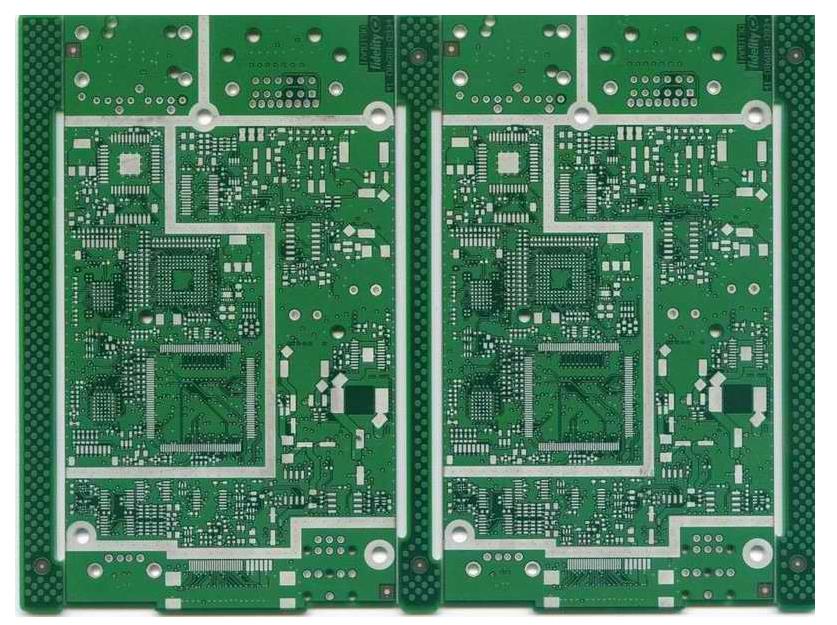Printed circuit boards made of ordinary composite materials mainly use glass fiber as the filler of the dielectric layer, but the special woven structure of glass fiber changes the local dielectric constant of the PCB board. Especially at millimeter wave frequencies, the glass weaving effect of thinner laminates becomes more obvious, and the local non-uniformity of Dk causes significant changes in the performance of radio frequency circuits and antennas. We used a 100 μm thick glass woven PTFE laminate to study the influence of the PCB structure on the performance of the transmission line, depending on the type of the glass woven structure, and found that the dielectric constant of the PCB board is 0.01-0.22. The result is fluctuating between the two. In order to study the influence of various glass braided structures on the antenna performance, a series-fed microstrip patch array antenna was constructed on Rogers commercial laminate RO4835 and RO4830 thermosetting laminate. The experimental results show: The electrical performance of the antenna processed by RO4830 laminate According to the conventional tolerance, it is more consistent with the calculated value, the change is smaller, and the reflectivity and boresight gain performance are improved.

Self-driving cars are currently being studied, while drivers and pedestrians avoid fatal accidents and require high reliability, and self-driving cars, that is, drivers and pedestrians, are currently being studied. Help people avoid fatal accidents and require high reliability. Therefore, these component circuits must be highly reliable. The millimeter wave radar has a compact design and high environmental detection sensitivity, providing a reliable target detection solution for autonomous driving. For commercial millimeter-wave radar systems with a frequency range of 76 to 81 GHz, the cross-fed microstrip antenna has a simple design, compact structure, mass production, and low production cost.
(1). The higher the frequency, the shorter the wavelength, so the size of transmission lines and antennas operating at millimeter wave frequencies is smaller than at low frequencies. In order to ensure the perfect performance of automotive radar, it is necessary to study the impact of PCB on transmission lines and microstrip antennas. For millimeter-wave frequency circuits that work under the external environment (affected by temperature and humidity) for a long time.
(2). The first thing to consider when choosing a PCB circuit laminate is the consistency of material performance indicators. However, copper foil, glass fiber reinforced materials, ceramic fillers and other materials that make up the laminate have a significant impact on the consistency of the indicator at high frequencies. get up. Therefore, these component circuits must be highly reliable.
Composition of laminate
Laminates are usually made by combining glass fiber cloth and polymer resin to form a dielectric layer, and then covering both sides with copper foil. The typical dielectric constant (Dk) of glass cloth is relatively high, about 6.1, while the dielectric constant Dk of low-loss polymer resin is 2.1-3.0, so there is a certain difference in Dk in a smaller area. Figure 1 shows a microscopic top view and cross-section of the glass braided fiber in the laminate. The periphery on the "knuckle bundle" has a higher Dk due to the higher glass fiber content, and the periphery on the "bundle" has a higher Dk due to the higher resin content. Low minimum value In addition, many factors such as the thickness of the glass fabric, the distance between the fabrics, the method of flattening the fabric, and the glass content of each axis will affect the performance of the glass fabric.
Impact on transmission line chain
This test uses a transmission line diagram of a microchip with a 1 mm terminal connector. The connector is first connected to a 50 ohm ground coplanar wave (GCPW) and converted to a high-impedance microcircuit transmission line through an impedance converter. The length of the microstrip transmission line is 2 inches. This allows the experimental protocol to test the effect of the glass texture structure. The solution uses a layer of copper and glass cloth, and is treated with a thin layer of polytetrafluoroethylene glass (PTFE). In order to compare the effects of different glass weave structures, we created a transmission line diagram using three different PCB laminate structures. 1080 glass fiber PTFE polytetrafluoroethylene fabric, 1078 glass fiber PTFE polytetrafluoroethylene ceramic fabric filled with PTFE laminate, 1080 glass fiber fabric. Carefully check the processed circuit, show a suitable transmission line for testing, and measure the amplitude and phase angle characteristics. The phase angle (the phase value after opening), the group delay (based on the change of the phase angle with frequency) and the propagation delay (calculated by the phase angle) are the three parameters that determine the constant dielectric constant of the laminate.
In summary
The structure of the laminate affects the performance of the transmission line and antenna. The glass fiber cloth construction method changes the dielectric constant on the line, reduces the performance of the product, and affects the quality of the product. Compared with RO4835 laminate, the antenna made of RO4830 laminate has better index performance compatibility. The improvement of antenna performance and process production is mainly due to the combination of composite materials: flat glass fiber fabric, low glass content (conductor away from glass fiber), thick coating, etc. The antenna efficiency is related to the electrical properties of materials such as RO4830 laminates, which have low dielectric constant and low loss tangent. Therefore, the performance and compatibility of the antenna made of Rogers RO4830 laminate using low-wavelength millimeter frequency radar is better than that of the antenna made of RO4835 laminate.